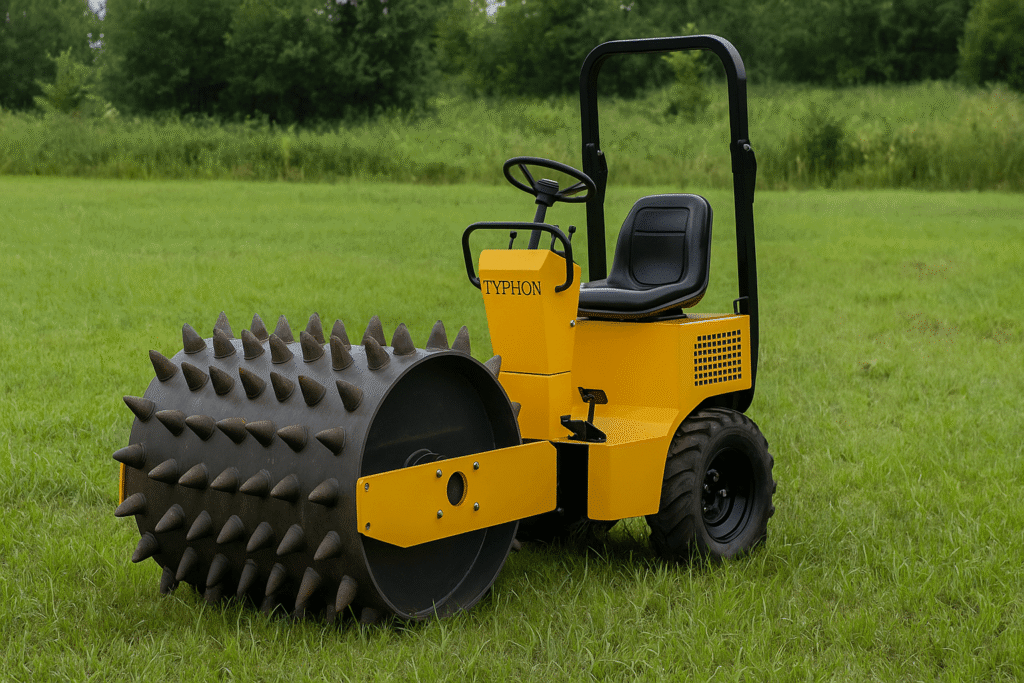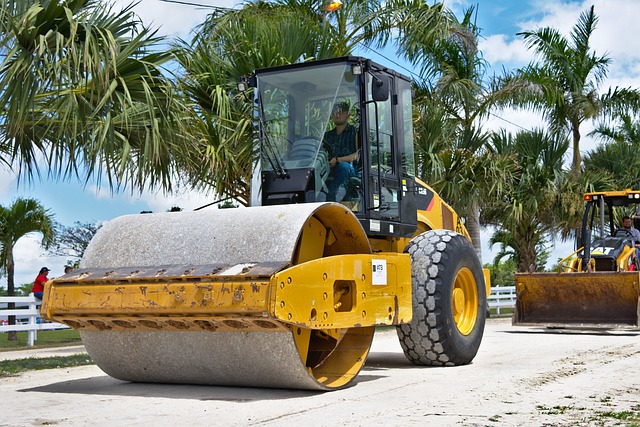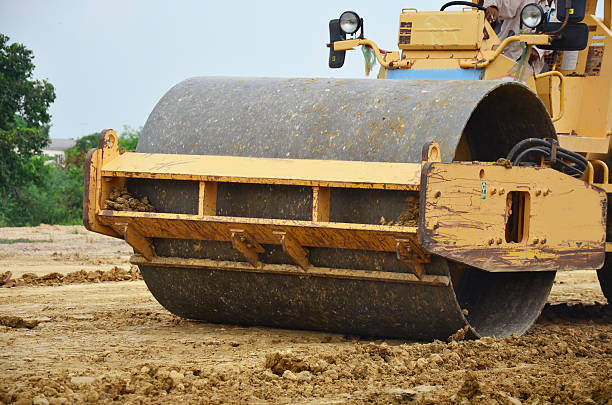A roller compactor with spikes is a specialized type of construction equipment designed for enhanced soil and material compaction. Unlike traditional smooth drum rollers, these compactors feature drums fitted with metal spikes or pads that penetrate and break up soil clumps during operation. This design increases compaction efficiency by applying higher pressure at spike tips, improving soil density, stability, and surface traction.
Design and Functionality of Roller Compactors with Spikes
Roller compactors with spikes have a drum surface embedded with robust, wear-resistant metal spikes made from materials such as hardened steel. These spikes penetrate deeper into soil or aggregate layers, redistributing particles more effectively. The compactor frame supports the drum, engine, hydraulic systems, and operator cabin with controls for adjusting speed and vibration intensity. The compactors exert vertical compaction forces, and the spikes focus this force onto smaller contact points to boost penetration and soil aggregation.
Advantages of Spike-Equipped Compactors
-
Increased Penetration: The spikes concentrate pressure, enabling deeper and more effective compaction in fewer passes compared to smooth-drum rollers.
-
Better Soil Aggregation: Penetration and disruption of soil particles reduce voids and air pockets, achieving greater soil density and load-bearing capacity.
-
Enhanced Traction and Stability: Spikes improve grip on uneven or slippery surfaces, beneficial in challenging terrains or wet conditions.
-
Versatile Applications: Ideal for road construction, landscaping, municipal projects, and industrial site development. The spikes ensure uniform compaction conducive to long-lasting, stable surfaces.
Typhon Machinery Roller Compactors
Typhon Machinery offers advanced roller compactors exemplified by the TYPHON Fury 1 Ton Vibratory Compactor, built for versatile use in road construction, landscaping, playgrounds, and municipal works. Although primarily described as a vibratory compactor with smooth steel drums, Typhon’s rollers feature powerful hydraulic systems, electric starting modes, and compact designs for maneuverability in confined spaces. Their machines deliver superior compaction force, ensuring smooth, rapid results and operational ease with intuitive controls and safety features.
Typhon’s reputation for innovation suggests potential models with spike-equipped drums or attachment options designed to combine vibratory compaction with spike benefits, enhancing performance on difficult soils and layered materials.
Roller compactors with spikes represent a significant upgrade over conventional rollers by improving soil compaction depth, density, and stability through mechanical soil penetration. Typhon Machinery’s rollers, known for robust hydraulic systems and versatility, align well with these innovations, making them a strong choice for contractors seeking efficient, reliable rollers for a range of compacting tasks. Spike-enhanced rollers particularly excel in roadwork, landscaping, and municipal projects where enhanced soil stability and surface traction are critical for long-term success.
How do spikes improve soil compaction efficiency in rollers
Spikes improve soil compaction efficiency in rollers by concentrating the compaction force onto smaller, focused points that penetrate deeper into the soil. This penetration breaks up soil clumps, redistributes soil particles more effectively, and reduces air voids within the soil structure. As a result, the soil becomes denser and more stable with fewer compaction passes compared to smooth drum rollers.
Specifically, the spikes:
-
Increase the vertical pressure at the contact points, allowing the roller to compact soil layers beneath the surface, rather than only compressing the top layer.
-
Disrupt soil aggregates and reorient soil particles to fill voids, enhancing soil cohesion and load-bearing capacity.
-
Improve traction of the roller on challenging or uneven terrain, enabling more consistent compaction performance.
This mechanism means spike-equipped rollers achieve superior compaction quality and efficiency, especially in granular or mixed soil types, as well as in layered or difficult-to-compact materials.
How do spike roller compactors compare to vibratory rollers
Spike roller compactors and vibratory rollers differ primarily in their compaction mechanisms, drum design, and optimal applications, though both aim to improve soil compaction efficiency.
Spike Roller Compactors
-
Compaction Mechanism: Use drums fitted with metal spikes or pads that penetrate and break up soil clumps. The spikes concentrate the roller’s weight on smaller surface points, increasing pressure and enabling deeper penetration.
-
Advantages: Enhanced penetration, breaking up compacted material more effectively, reducing passes needed for dense soil, and improving traction on uneven or slippery surfaces.
-
Best Use: Suitable for compacting granular soils, cohesive soils needing surface disruption, and challenging terrain where increased grip is beneficial.
Vibratory Rollers
-
Compaction Mechanism: Use smooth steel drums that generate high-frequency vibrations combined with static weight. The vibrations reduce internal friction and air voids by allowing soil or aggregate particles to rearrange and compact more densely.
-
Advantages: Faster compaction over large areas, better suited for deep compaction especially on granular and semi-cohesive soils, and high productivity due to vibrational energy.
-
Best Use: Ideal for large-scale projects like road construction and asphalt paving where deep and uniform compaction over broad surfaces is required.
Direct Comparison
| Feature | Spike Roller Compactors | Vibratory Rollers |
|---|---|---|
| Drum Type | Drums with protruding metal spikes | Smooth steel drums with vibrating mechanism |
| Compaction Force | Concentrated pressure at spike tips | Combination of static weight + vibration |
| Soil Penetration | Deep due to spike penetration | Deep due to vibration energy |
| Surface Traction | High due to spikes enhancing grip | Standard, less grip than spike type |
| Ideal Soils | Granular, mixed, and cohesive (surface-friendly) | Granular and semi-cohesive soils |
| Efficiency | Requires fewer passes on varied terrains | Higher productivity on large, flat areas |
| Surface Finish | Can disturb topsoil surface slightly | Provides smoother surface finish |
| Typical Applications | Uneven terrain, landscaping, municipal jobs | Roads, asphalt paving, large industrial sites |
In summary, spike roller compactors excel in penetration and traction where soil disruption and gripping are needed, making them effective for tougher terrains and mixed soil types. Vibratory rollers achieve faster, deeper compaction on extensive granular soil or asphalt surfaces, offering high productivity and smooth finishes. Selection depends on project scale, soil type, and surface finish requirements.
What are the cost differences between spike and vibratory rollers
The cost differences between spike roller compactors and vibratory rollers vary based on design complexity, features, and applications, but here are the general insights:
Spike Roller Compactor Costs
-
Spike rollers tend to have specialized drums with protruding metal spikes made from durable materials like hardened steel, which can increase manufacturing costs.
-
Prices for roller compactors with spikes can start from approximately $900 for smaller models, but larger, industrial-grade spike rollers will cost significantly more depending on engine power and build quality.
-
Spike rollers often have simpler mechanics compared to vibratory rollers but may involve higher maintenance costs on the spikes themselves due to wear and tear.
Vibratory Roller Costs
-
Vibratory rollers usually cost more upfront due to complex components including vibration mechanisms, hydraulic systems, and controls for varying frequencies and amplitudes.
-
Entry-level walk-behind vibratory rollers can start from a few thousand dollars (around $2,000 – $3,500), while larger ride-on vibratory rollers can range from about $25,000 to several hundred thousand dollars depending on size and features.
-
They provide higher productivity and compaction efficiency which can translate to cost savings on larger projects.
Cost Comparison Summary
| Aspect | Spike Roller Compactors | Vibratory Rollers |
|---|---|---|
| Starting Price Range | From approx. $900 (small models) | From approx. $2,000-$3,500 (small) |
| Industrial Model Prices | Moderate to high depending on specs | Wide range up to $100,000+ for large models |
| Complexity & Features | Simpler mechanical design, spike wear maintenance | Complex vibration systems, adjustable frequency |
| Maintenance Costs | Moderate, focused on spike wear and replacement | Potentially higher for vibration system upkeep |
| Productivity & Efficiency | Good for specialized penetration tasks | High, suitable for large-scale projects |
In summary, spike rollers may be more economical upfront for smaller or specialized jobs, while vibratory rollers, though generally higher in cost, offer efficiency and versatility for larger projects. The exact cost depends on the machine size, power, and manufacturer specifications including Typhon Machinery models.
What are the maintenance costs for spike versus vibratory rollers
Maintenance costs for spike roller compactors and vibratory rollers differ mainly due to the complexity of their mechanical systems and wear components.
Maintenance Costs for Spike Roller Compactors
-
Spike rollers require regular inspection and maintenance of the metal spikes themselves, which can wear out or break over time and need timely replacement or repair to maintain compaction performance.
-
Cleaning and rust prevention of spikes and areas between them are important to avoid corrosion, adding to routine servicing.
-
Generally, spike rollers have a simpler mechanical design with fewer moving parts than vibratory rollers, which can result in moderately lower maintenance costs.
-
Maintenance tasks typically include checking spikes before and after every use, lubricating moving parts, and servicing the engine and hydraulic systems.
Maintenance Costs for Vibratory Rollers
-
Vibratory rollers have more complex mechanisms, including vibration components like eccentric shafts, springs, bearings, and hydraulic vibration motors that require more frequent and detailed maintenance.
-
Key maintenance includes regular lubrication, inspection and replacement of vibration system parts, and monitoring hydraulic fluid and components to avoid leaks and wear.
-
The vibration system introduces additional wear points, leading to potentially higher maintenance and repair costs over the roller’s lifespan.
-
Servicing intervals are generally closer together, especially with heavy use, and neglect can lead to costly breakdowns of the vibratory mechanism.
-
Proper handling and storage practices are critical in minimizing premature wear.
Summary Comparison of Maintenance Costs
| Maintenance Aspect | Spike Roller Compactors | Vibratory Rollers |
|---|---|---|
| Mechanical Complexity | Simpler design, fewer moving parts | Complex vibration mechanism |
| Wear Parts | Spikes require periodic replacement | Bearings, springs, vibration motors need frequent care |
| Cleaning & Rust Prevention | Important for spikes and drum | Standard cleaning for drum and hydraulic system |
| Inspection Frequency | Regular pre/post operation checks | Frequent detailed vibration system checks |
| Potential Repair Costs | Moderate, focused on spikes and hydraulics | Higher due to vibration system components |
| Downtime Risk from Neglect | Moderate | High, can lead to major breakdowns |
In essence, spike rollers usually incur lower maintenance costs due to simpler construction but require careful upkeep of the spikes. Vibratory rollers have higher maintenance needs and costs attributed to their complex vibrating mechanisms but offer greater efficiency and output for larger projects. Preventative regular maintenance on both types helps minimize expensive repairs and downtime.
How often should each roller type undergo maintenance checks
The frequency of maintenance checks for spike roller compactors and vibratory rollers depends on usage intensity, operating conditions, and manufacturer recommendations, but here are general guidelines:
Spike Roller Compactors
-
Daily Checks: Before and after each use, inspect spikes for wear, damage, or loosening; check hydraulic fluid levels, engine oil, and overall machine condition.
-
Weekly Maintenance: Clean the spike drum to prevent rust and debris buildup; lubricate necessary components per the manufacturer’s manual.
-
Monthly or After Certain Hours (e.g., every 50-100 hours): Conduct thorough inspections of spikes, hydraulic system, engine performance, and structural components.
-
Annual or Long-Term: Comprehensive service including replacement of worn spikes, hydraulic fluid changes, engine tune-up, and safety system tests.
Vibratory Rollers
-
Daily Checks: Inspect the drum and vibrating components visually, check hydraulic fluid and engine oil levels, verify vibration system operation.
-
Weekly Maintenance: Lubricate vibration system bearings and shafts, check all mountings and fasteners, clean the machine thoroughly.
-
Every 50-100 Hours: Detailed inspection of vibration motor, bearings, eccentric shaft, springs, hydraulic system, and engine; replace fluids and worn parts as needed.
-
Annual or After 1000+ Hours: Major maintenance including vibration system overhaul, hydraulic system flushing and sealing, engine servicing, and structural checks.
Summary Table
| Maintenance Interval | Spike Roller Compactors | Vibratory Rollers |
|---|---|---|
| Daily | Spike inspection, fluid levels | Drum, vibration system, fluid levels |
| Weekly | Cleaning, lubrication | Lubrication of vibration parts, cleaning |
| Every 50-100 hours | Spike wear, hydraulics, engine | Detailed vibration system and engine checks |
| Annual/Long-term | Spike replacement, full servicing | Vibration system overhaul, engine tune-up |
Regular adherence to these schedules ensures optimal performance, longevity, and safety of the rollers. Typhon Machinery and other manufacturers typically provide detailed service manuals specifying exact intervals and procedures.





